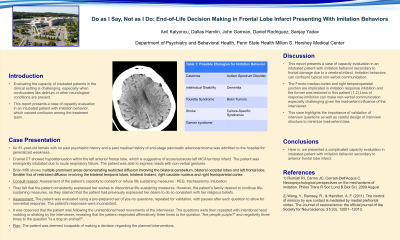Neurocognitive Disorders, Delirium, and Neuropsychiatry
Session: Poster Session
(082) Do as I Say, Not as I Do: End-of-Life Decision Making in Frontal Lobe Infarct Presenting With Imitation Behaviors

Trainee Involvement: Yes
.jpg)
Anil Kalyoncu, MD
Resident Physician
Penn State College of Medicine
Hershey, Pennsylvania, United States
Dallas Hamlin, MD
Psychiatry Resident
Penn State Milton S Hershey Medical Center
Hershey, Pennsylvania, United States- JG
John Garman, MD
PGY2 Psychiatry
Penn State Psychiatry
Mechanicsburg, Pennsylvania, United States - DR
Daniel Rodriguez, II, MSN, CRNP
CRNP CL-Psychiatry
Penn State Health
Hershey, Pennsylvania, United States - SY
Sanjay Yadav, MD
Consultation-Liaison Psychiatrist
Penn State Health Hershey Medical Center
Hershey, Pennsylvania, United States
Presenting Author(s)
Co-Author(s)
Evaluating the capacity of intubated patients in the clinical setting is challenging, especially when confounders like delirium or other neurological conditions are present. This report presents a case of capacity evaluation in an intubated patient with imitation behavior, which caused confusion among the treatment team. An 81-year-old female with no past psychiatric history and a past medical history of end-stage pancreatic adenocarcinoma was admitted to the hospital for generalized weakness. Cranial CT showed hypoattenuation within the left anterior frontal lobe, which is suggestive of acute/subacute left MCA territory infarct. The patient was emergently intubated due to acute respiratory failure. Afterwards, the treatment team wanted to discuss goals of care with the patient. The primary team reported that the patient was able to express needs with non-verbal gestures. They felt that the patient consistently expressed her wishes to discontinue life-sustaining measures, including intubation, percutaneous endoscopic gastrostomy (PEG) placement, and tracheostomy. However, the patient's family desired to continue life-sustaining measures, as they claimed that the patient had previously expressed her desire to do so consistent with her religious beliefs. Therefore, the primary team consulted psychiatry to assess the patient's capacity to consent or refuse these procedures. The patient was evaluated using a pre-prepared set of yes-no questions, repeated for validation, with pauses after each question to allow for nonverbal response. The patient's responses were inconsistent. It was observed that the patient was following the unintentional head movements of the interviewer. The questions were then repeated with intentional head nodding or shaking by the interviewer, revealing that the patient responded affirmatively three times to the question "Are people purple?" and negatively three times to the question "Is a dog an animal?". Subsequently, the patient was deemed incapable of making a decision regarding the planned interventions. This report presents a case of capacity evaluation in an intubated patient with imitation behavior secondary to frontal damage due to a cerebral infarct. Imitation behaviors can confound typical non-verbal communication. The Fronto-median cortex and right temporoparietal junction are implicated in imitation response inhibition,1,2 and the former was lesioned in this patient. Loss of response inhibition can make non-verbal communication especially challenging given the inadvertent influence of the interviewer. This case highlights the importance of validation of interview questions as well as careful design of interview structure to minimize inadvertent bias. Here in, we presented a complicated capacity evaluation in intubated patient with imitation behavior secondary to anterior frontal lobe infarct. 1)Rumiati RI, Carmo JC, Corradi-Dell'Acqua C. Neuropsychological perspectives on the mechanisms of imitation. Philos Trans R Soc Lond B Biol Sci. 2009 August 2) Wang, Y., Ramsey, R., & Hamilton, A. F. (2011). The control of mimicry by eye contact is mediated by medial prefrontal cortex. The Journal of neuroscience: the official journal of the Society for Neuroscience, 31(33), 12001–12010.
Background:
Case presentation:
Discussion:
Conclusion:
References:

